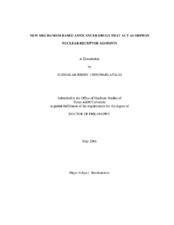| dc.description.abstract | 1,1-Bis(3'-indolyl)-1-(p-substitutedphenyl)methanes containing ptrifluoromethyl
(DIM-C-pPhCF3), p-t-butyl (DIM-C-pPhtBu), and phenyl (DIM-CpPhC6H5)
substituents have been identified as a new class of peroxisome proliferatoractivated
receptor γ (PPARγ) agonists that exhibit antitumorigenic activity. In this study,
the PPARγ-active compounds decreased HT-29, HCT-15, RKO, HCT116 and SW480
colon cancer cell survival and KU7 and 253JB-V33 bladder cancer cell survival. In HT-
29, HCT-15, SW480 and KU7 cells, the PPARγ agonists induced caveolin-1 expression
and this induction was significantly downregulated after cotreatment with the PPARγ
antagonist GW9662. Since overexpression of caveolin-1 is known to suppress cancer
cell and tumor growth, the growth inhibitory effects of the DIM compounds in these cell
lines are associated with PPARγ-dependent induction of caveolins. These PPARγ-active
compounds did not induce caveolin-1 in HCT-116 cells. However, these compounds
induced NSAID-activated gene-1 (NAG-1) and apoptosis in this cell line. This
represents a novel receptor-independent pathway for C-DIM-induced growth inhibition and apoptosis in colon cancer cells. In SW480 colon cancer cells 2.5-7.5 μM C-DIMs
induced caveolin-1 whereas high concentrations (10 μM) induced pro-apoptotic NAG-1
expression. In athymic nude mice bearing SW480 cell xenografts DIM-C-pPhC6H5
inhibited tumor growth and immunohistochemical staining of the tumors show induction
of apoptosis and NAG-1 expression. Thus, the PPARγ-active compounds induce both
receptor-dependent and-independent responses in SW480 cells which are separable over
a narrow range of concentrations and this dual mechanism of action enhances their
antiproliferative and anticancer activities. Similar results were obtained for another
structural class of PPARγ agonists namely 2-cyano-3,12-dioxoolean-1,9-dien-28-oic
acid (CDDO) and the corresponding methyl (CDDO-Me) and imidazole (CDDO-Im)
esters. Structure-activity studies show that 1,1-bis(3'-indolyl)-1-(psubstitutedphenyl)
methanes containing p-trifluoromethyl (DIM-C-pPhCF3), hydrogen
(DIM-C-pPh) and p-methoxy (DIM-C-pPhOCH3) substituents activate Nur77 and induce
apoptosis in pancreatic, prostate, and breast cancer cell lines. Nur77 agonists activate the
nuclear receptor, and downstream responses include decreased cell survival, induction of
cell death pathways including tumor necrosis factor related apoptosis-inducing ligand
(TRAIL) and PARP cleavage. Nur77 agonists also inhibit tumor growth in vivo in
athymic nude mice bearing Panc-28 cell xenografts. | en |


